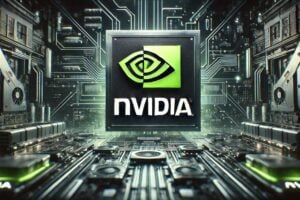Nvidia has recently reached a historic milestone in the financial markets, surpassing Apple in terms of market capitalization and establishing itself as a leader in the technology and innovation sector. However, what surprised many analysts was the role that Trump’s policies and their impact on the landscape of technological exports played in further strengthening the company’s position. This article will explore how the economic policies of the United States, combined with Nvidia’s leadership in artificial intelligence, have made this epochal leap possible.
Nvidia’s Overtaking of Apple: The Trump Effect Returns
In an economic context dominated by innovation and technological progress, Nvidia (NVDA) has surpassed Apple in market capitalization, marking a crucial milestone for the sector. This result has been driven primarily by the growing demand for technologies related to artificial intelligence (AI), advanced graphics processing, and semiconductors, areas in which Nvidia is the undisputed protagonist. With a market capitalization that has exceeded 2.7 trillion dollars, the company has demonstrated that it is not only a technological innovator but also an absolute leader in long-term investments.
The semiconductor and AI sector is attracting more and more capital and attention, thanks to its applications in various fields: from autonomous driving to industrial automation, up to cloud infrastructure. Nvidia has been able to ride this wave, offering financial markets a clear vision of sustainable growth. However, there is a crucial factor that has further strengthened the company’s position: the impact of Donald Trump’s policies on tech trade.
The impact of Trump’s policies on Nvidia’s success
Trump’s actions during his tenure as president of the United States had a significant influence on the economic dynamics that now favor Nvidia. One of the most relevant aspects was the policy of limiting U.S. technological exports to countries like China, a move that encouraged American companies to focus on internal growth and the expansion of their technological leadership.
Nvidia, with its dominant position in the high-end processor market and AI solutions, has benefited from this political and commercial context. The limitations imposed on exports to China, while representing a potential risk for US tech companies, have pushed investors and local companies to strengthen confidence in internal capabilities, aiming for technological self-sufficiency. Nvidia has become the emblem of this strategy, attracting significant investments and consolidating its role in the global market.
The AI revolution and the strategic dominance of Nvidia
In parallel with the political context, the revolution linked to artificial intelligence has played a fundamental role in the success of Nvidia. For several years, the company has been considered a leader in hardware solutions for AI thanks to its high-performance GPUs, essential for machine learning processes and complex calculations. This key position is further strengthened by the growing demand for more efficient and powerful AI models.
It is not a coincidence that Nvidia has been one of the main beneficiaries of the growing adoption of chatbots and generative artificial intelligence tools like ChatGPT and other similar models. Its GPUs are at the heart of the cloud infrastructures used to train and deploy these innovative technologies.
To this is added the fact that the United States government initiatives – led in part by the Trump administration – have contributed to stimulating research and development in the technology sector, creating a fertile environment for companies like Nvidia.
Nvidia and the strategy for the future
Looking to the future, Nvidia seems intent on further consolidating its position in the semiconductor and AI market. The company is expanding its reach with the goal of conquering new markets and innovative applications, such as virtual reality, smart city infrastructures, and advanced automation. Additionally, the journey towards greater energy independence and sustainability could see Nvidia play a leading role with solutions designed to improve the energy efficiency of electronic devices.
The company’s prospects are further strengthened by strategic alliances and the continuous search for new business opportunities in emerging markets. With the ongoing demand for high-performance hardware and the large-scale adoption of AI technologies, Nvidia aims to maintain a competitive edge that allows it to continue competing with other major players like Apple, Microsoft, and Google.
A milestone that inaugurates a new technological era
The overtaking of Nvidia over Apple in terms of market capitalization represents much more than a simple financial victory: it is a key indicator of how the technology sector is evolving. The intersection between the rise of AI, the semiconductor market, and the geopolitical context is shaping a new world order, in which Nvidia emerges as the main protagonist.
The effect of Trump’s policies on tech trade has undoubtedly contributed to this shift, but Nvidia’s success is also the result of its ability to constantly innovate. In an era where artificial intelligence and advanced applications dominate the vision of the future, Nvidia seems destined to remain at the top of the tech podium for a very long time.


